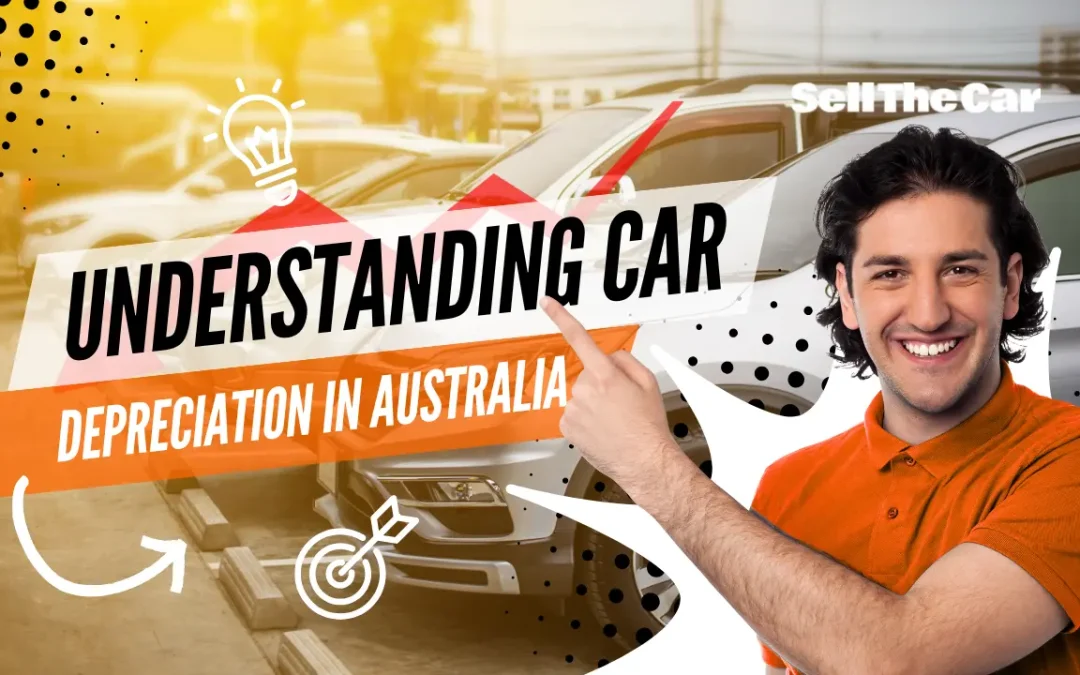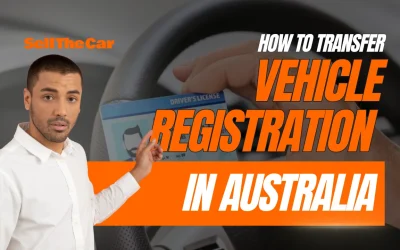Whether you’re buying a new ride or thinking of selling your current set of wheels, car depreciation is one of the most important factors to consider. In Australia, vehicle values can drop quickly and understanding this drop can help you make better buying, selling and tax decisions.
Let’s unpack car depreciation in Australia from how it works, to how the ATO calculates it and what you can do to slow it down.
What Is Car Depreciation
Car depreciation happens when your vehicle’s value falls over time. In Australia, this can start immediately, with a new car losing 10% to 15% of its value as soon as you take it home from the dealer. This drop occurs because the car is no longer considered “new” and is now competing in the used car market, regardless of its condition.
Why Car Depreciation Is More Important Than You Think
Car depreciation isn’t just about losing value on paper, it has real financial consequences, including:
- Resale Value: The amount you’ll get when you sell or trade in your vehicle.
- Car Loan Equity: Whether your loan balance is higher than the car’s current market value (negative equity).
- Tax Deductions: If you use your car for business, depreciation can be claimed as a tax deduction within ATO guidelines.
Factors That Influence Car Depreciation in Australia
Car depreciation isn’t random; it’s shaped by a combination of market forces and how you own, maintain and present your vehicle. Knowing these factors can help you slow down value loss and make better buying and selling decisions.
1. Brand
Not all car brands lose value at the same rate.
- Hold Value Well: Toyota, Mazda, Hyundai, Kia known for reliability, affordable servicing and strong buyer demand.
- Depreciate Faster: Lesser-known or new brands with limited dealership networks or harder-to-find parts.
Example: A Toyota Corolla will generally hold its value better over five years compared to a newer brand sedan with similar features.
2. Model
The make and model of your vehicle plays a huge role in how quickly it loses value.
- High-demand models: such as large SUVs, dual-cab utes and popular family cars tend to depreciate more slowly because there’s always a market for them.
- Limited editions or vehicles with standout features (e.g., special trim levels, advanced safety tech or rare colour options) can also maintain higher resale prices.
Example: A Toyota LandCruiser or Ford Ranger Wildtrak will typically hold its value better than a low-demand compact sedan, even after several years of use.
3. Age
A car’s age is one of the strongest predictors of depreciation. The sharpest decline happens in the early years of ownership:
- First 12 months: Around 10–15% depreciation as the car shifts from “new” to “used.”
- First 3 years: Value loss can reach 40–50% of the original price.
- After 5 years: Many cars lose 60% or more of their original worth, unless they’re collectible or extremely well maintained.
The biggest drop is unavoidable, but choosing a near-new used car can help you avoid the steepest depreciation hit.
4. Condition
The physical and mechanical condition of your car has a direct impact on resale value. Buyers are willing to pay more for a vehicle that’s been clearly looked after.
- Good: Regular servicing, a clean and well-kept interior, minimal scratches or dents.
- Bad: Accident history, neglected maintenance, obvious wear and tear or smoking/pet odours in the cabin.
A complete and up-to-date service logbook is a major selling point in Australia, as it shows the car has been maintained according to manufacturer guidelines.
5. Mileage
A car’s mileage is one of the first things buyers check when considering a purchase.
- Lower kilometres = higher resale value, as it usually means less wear and tear.
- In Australia, the average annual mileage is around 15,000–20,000 km. Cars driven well under this range often command a premium.
- Well-maintained low-mileage cars can sell faster and for significantly more — especially if paired with a full service history.
Pro tip: If you want to protect your car’s value, avoid unnecessary trips and keep long-distance driving to a minimum.
6. Market Demand
Market trends play a big role in how much your car is worth.
- High demand, low supply means slower depreciation common for fuel-efficient hatchbacks, hybrids, electric vehicles and 4WD utes in Australia’s current market.
- Low demand, high supply models, like large petrol SUVs with poor fuel economy, tend to lose value quickly.
Demand can change fast fuel price hikes, government incentives, or new tech can shift buyer preferences almost overnight.
7. Fuel Efficiency
With petrol prices continuing to rise, fuel efficiency is a major selling point for Australian buyers.
- Hybrids, EVs and small-capacity engines generally depreciate slower because they cost less to run.
- Fuel-hungry performance cars and large petrol engines tend to depreciate faster unless they’re rare or collectible, in which case enthusiast demand can help retain value.
Choosing a fuel-efficient model not only saves money at the bowser but can also help keep your car’s resale value stronger over time.
8. Transmission
In Australia, automatic transmissions dominate the market because they’re easier to drive in heavy traffic and appeal to a wider buyer base. As a result, automatics generally retain value better than manuals when it comes time to sell.
However, manual transmissions can still attract dedicated enthusiasts particularly in sports cars, classic vehicles and certain 4WD models but the resale market for manuals is smaller and more niche. If you’re aiming for broader resale appeal, an automatic is usually the safer choice.
9. Maintenance History
A complete and well-documented maintenance history is one of the most powerful tools for preserving your car’s value. It signals to potential buyers that the vehicle has been well cared for, reducing perceived risk.
- Keep everything: Save all receipts, invoices and service reports.
- Follow the logbook: Stick to the manufacturer’s recommended service schedule.
Extra bonus: Major repairs or upgrades (e.g., new tyres, timing belt replacement) can be highlighted in your sale listing to justify a higher asking price.
Cars with a full logbook service history tend to sell faster and fetch higher prices, as buyers feel more confident they’re getting a reliable vehicle.
10. Climate Exposure
Australia’s weather can take a serious toll on your car’s value if it’s not protected.
- Hot, dry regions: Prolonged sun exposure can fade paint, crack dashboards and cause interior materials to wear out faster.
- Coastal areas: Salt in the air can accelerate rust and corrosion, especially underneath the chassis and around wheel arches.
- Tropical climates: Humidity can lead to mould, electrical issues and quicker deterioration of fabrics.
Prevention tip: Parking in a garage, under a carport or using a high-quality UV and weather-resistant car cover can significantly reduce weather related depreciation. Regular washing and waxing also protect against sun and salt damage.
11. Aftermarket Modifications
While some upgrades can make your car more appealing, many modifications actually hurt resale value.
- Mods that often reduce value: Loud exhaust systems, extreme suspension changes, oversized spoilers or custom body kits that limit buyer appeal.
- Mods that can add value: Practical and reversible upgrades like quality alloy wheels, factory-style tow bars, roof racks or upgraded infotainment systems provided they suit your target buyer’s needs.
Pro tip: Most buyers prefer vehicles close to factory condition because they’re easier to insure, maintain and trust. Overly customised cars can raise red flags about previous use and potential wear.
Car Depreciation Rates in Australia
| Age of Car | Average Depreciation (Total Loss in Value) |
|---|---|
| 1 Year | 10–15% |
| 3 Years | 40–50% |
| 5 Years | 55–65% |
| 10 Years | 80%+ |
The Impact of Car Ownership on Depreciation
Owning a car means accepting that its value will drop over time but the biggest hit happens the moment you drive it out of the dealership. In Australia, a new car can lose 10–15% of its value in the first year alone, and then continue to depreciate at around 10–15% each year after that.
This happens regardless of how well the car runs or looks, depreciation is driven by age, market demand and perceived value, not just condition.
Example: How a $30,000 Car Depreciates Over 5 Years
Let’s say you buy a new car for $30,000. If it loses 12.5% in the first year, that’s a drop of $3,750, bringing its value down to $26,250.
If the car then depreciates at 15% per year for the next four years, here’s what happens:
| Year | Value at Start of Year | Depreciation Rate | Depreciation Amount | Value at End of Year |
|---|---|---|---|---|
| 1 | $30,000 | 12.5% | $3,750 | $26,250 |
| 2 | $26,250 | 15% | $3,937.50 | $22,312.50 |
| 3 | $22,312.50 | 15% | $3,346.88 | $18,965.63 |
| 4 | $18,965.63 | 15% | $2,844.84 | $16,120.79 |
| 5 | $16,120.79 | 15% | $2,418.12 | $13,702.67 |
By the end of five years, the car’s value had dropped from $30,000 to about $13,700 losing over half its original worth.
Read More – Australia’s Best Small Cars to Buy in 2025
How to Minimise Car Depreciation in Australia
While car depreciation is unavoidable, there are smart ways to slow it down and keep more value in your vehicle over time. The key is to choose wisely, maintain consistently and protect your car from unnecessary wear.
1. Keep Up with Regular Maintenance
A well-maintained car is worth more.
- Stick to your manufacturer’s recommended service schedule.
- Keep a complete service logbook, it reassures buyers your car has been cared for.
- Address small issues early to avoid costly repairs later.
2. Limit Your Mileage
The fewer kilometres on the odometer, the higher the resale value.
- The Australian average is 15,000–20,000 km/year staying under this helps slow depreciation.
- Use public transport or carpooling for non-essential trips to keep mileage low.
3. Choose Resale-Friendly Models
Some vehicles naturally hold value better.
- Research brands and models with strong resale reputations like Toyota, Mazda, or Hyundai.
- Consider high-demand body types such as SUVs, dual-cab utes or hybrids that attract more buyers when it’s time to sell.
4. Protect from Harsh Weather
Australia’s climate can damage a car’s paint, interior and mechanical parts.
- Store your car in a garage or under a carport.
- Use a UV-resistant car cover if parking outdoors.
- Regularly wash and wax to protect against sun and salt damage, especially near the coast.
5. Avoid Unnecessary Modifications
Not all upgrades add value in fact, many can hurt resale.
- Skip extreme customisations like oversized spoilers, loud exhausts, or heavy suspension changes.
- Stick to practical, reversible upgrades like roof racks or quality alloy wheels if they match buyer demand.
Pro tip: Selling your car before major model updates or before the warranty expires can also help you get a higher price.
Real-World Depreciation – Top-Selling Models (3-Year Period)
| Make & Model | Original Price | Resale Value | Depreciation Rate |
|---|---|---|---|
| Toyota HiLux Rogue (4x4 Auto) | $83,930 | $58,050 | 30.8% |
| Ford Ranger Raptor (4x4 Auto) | $84,150 | $65,600 | 22% |
| Toyota RAV4 Cruiser Hybrid | $63,250 | $42,250 | 33.2% |
| Mitsubishi Triton GLX (4x2) | $42,900 | $28,950 | 32.5% |
| Mazda CX-5 Touring Active AWD | $46,200 | $27,200 | 41.1% |
Source: RedBook & market estimates
How to Calculate Car Depreciation in Australia
Simple Manual Method
- Find the original purchase price.
- Find the current market value (check RedBook,
- CarsGuide or contact Sell The Car for quick valuation).
- Subtract current value from original price = Total depreciation.
- Divide by original price × 100 = Depreciation rate.
Example:
Let’s say you bought your car for $40,000.
Today, it’s worth $25,000.
That means it’s lost $15,000 in value since you bought it.
To work out the depreciation rate:
- Take the drop in value ($15,000)
- Divide it by the original price ($40,000)
- Multiply by 100 to get the percentage
So in this case:
$15,000 ÷ $40,000 × 100 = 37.5% depreciation
In simple terms: Your car has lost about a third of its value since you bought it.
Want to Know Your Car’s True Value?
Get an instant online car valuation with Sell The Car. It’s quick, free and based on real Australian market data.
ATO Methods for Calculating Depreciation
The Australian Tax Office (ATO) allows two main methods for business-use cars:
Straight-Line Method
Same deduction each year over the car’s “effective life”.
Example: $50,000 purchase, 5-year life → $10,000/year.
Diminishing Value Method
Higher deduction in early years, less later.
Example: $50,000 at 25% rate → Year 1 = $12,500; Year 2 = $9,375, etc.
Claiming Car Depreciation on Taxes in Australia
Business Use Only – You can’t claim depreciation for purely personal cars.
Car Limit – 2025–26 financial year limit: $69,674.
Methods:
- Cents per km method (max 5,000 km) – covers fuel, maintenance and depreciation.
- Logbook method – track all expenses, calculate business-use percentage.
Instant Asset Write-Off: If eligible, you may claim the full car value in the purchase year. Check the ATO car depreciation calculator for accurate figures.
Car Depreciation and Car Loans
If your car’s value falls faster than you’re paying off the loan, you may owe more than it’s worth (“negative equity”).
To avoid this:
- Make a deposit when buying
- Choose models with slower depreciation
- Avoid overpaying for brand-new cars with rapid drop-offs
Ways to Slow Down Car Depreciation
- Keep mileage low
- Service regularly with a full logbook
- Store under cover or in a garage
- Avoid unnecessary modifications
- Sell before major model updates
- Choose fuel-efficient, in-demand models
Conclusion
Understanding car depreciation in Australia can save you thousands whether you’re buying, selling or claiming tax deductions. Use the ATO car depreciation calculator, keep your car well-maintained and choose models with slower depreciation to protect your investment.
At Sell The Car, we make it easy to find out what your car is worth right now. Our free online valuation tool gives you an instant estimate based on real Australian market data so you can make smarter decisions when it’s time to sell. Whether you want a fast sale or just want to know your car’s true value, we’re here to help you get the best possible outcome.
Car Depreciation FAQs
How much does a car depreciate each year in Australia?
In Australia, most cars lose 10–15% of their value in the first year. After that, it’s usually 10–12% per year, depending on the brand, model, and condition.
What’s the average life of a car in Australia?
The average car lasts around 10–12 years before major repairs make replacing it a better option. Well-maintained cars can last longer, especially if serviced regularly.
Can I claim car depreciation for tax?
Yes, if you use your car for business purposes. You can claim depreciation as a tax deduction, but only within the ATO’s limits and using an approved calculation method.
How do I calculate my car’s depreciation?
Subtract your car’s current market value from the price you paid for it, then divide that number by the purchase price and multiply by 100.
Example: Paid $40,000, now worth $25,000 → Depreciation = 37.5%.
What’s the ATO car depreciation limit in 2025–26?
The ATO’s car depreciation limit for the 2025–26 financial year is $69,674. You can’t claim depreciation on any value above that amount.
What is the ATO rule for depreciation of cars?
The ATO allows two main methods for calculating car depreciation for business use:
Diminishing Value Method – Larger deductions in the early years.
Straight-Line Method – Equal deductions each year over the car’s effective life.
You can only claim up to the car limit for the year you bought it.
Related Blogs
Switching Ownership of Vehicle: How to Transfer Vehicle Registration in Australia
Buying or selling a car in Australia or completing a vehicle change ownership process? Then you’ll need to transfer vehicle registration to make sure ownership is legally and officially changed. Whether you’re selling privately, gifting your car or buying from a...
Where To Sell My Car For Cash In Melbourne?
If you’re wondering “Where can I sell my car for cash in Melbourne?”, you’ve already taken the smartest first step toward turning your car into quick, guaranteed money. Whether it’s an old daily driver, a used family vehicle or a prestige car collecting dust in the...
Best Used Sedans in Australia 2025: Affordable & Reliable
Car preferences shift with time, just like music or fashion trends. In Australia, the spotlight is now on SUVs, but for decades, the sedan was the nation’s favourite family car. From Holden Commodores and Ford Falcons to Toyota Camrys, sedans were once the most...




